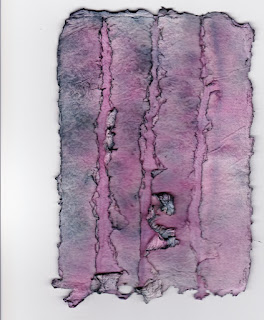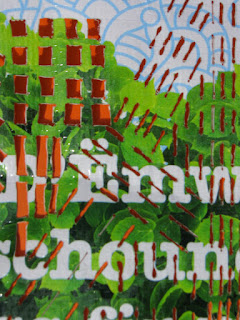The stamp represents Marie SPEYER (1880-1914), who went to university in Switzerland where women had been admitted since 1865. She finished her studies in literature in Prague with suma cum laude and then returned to Switzerland where she worked hard to give young girls the opportunity to do academic studies. Back in Luxembourg in 1911 she suffered a lot from what she called "a mental desert".
I thought that this destiny related well with my theme.
However, colouring the paper pulp according to the method recommended in this chapter was very disappointing, the colour washed out and left a pink and grey paper, something I didn't want.
The following samples are shown because of the different techniques but don't reflect the wanted colour scheme
the grey coloured pulp was spooned on top
partially formed sheets of grey and pink were overlapped on the "kitchen" cloth leaving larger areas of coloured paper
grey pulp was put onto the pink paper forming two rows. Unfortunately the picture doesn't render the resulting texture very well
here the texture is more obvious
fringing with a piece of packaging string
fringing with coins (shopping theme), here a grey paper sheet was put on the pink sheet
fringing with fabric strips
fringing with packaging string: grey on pink paper
I loved the process of using different coloured pulps especially the fringing method and the resulting coloured edges and textures.
However, as the colours didn't turn out as I initially planned I bought red paper to make the coloured pulp
red paper sheet, pulp made with red paper
here different sized wire formed into the word "List" were incorporated between two sheets of red paper and the letters were highlighted with Treasure Gold. I tried to bend the paper to give it a different shape. Of course this has to be done very carefully.
a long strip of paper was formed by overlapping partially formed sheets as suggested during my tutorial at Summer School. Small bits of paper resulting from a supermarket pay roll were included into the pulp
My biggest question now is whether I should continue trying to find a solution to my colour problem or changing to a completely different colour scheme,
As you can see from the dyed fabric below there is no problem to reproduce the colours in fabric.






















































